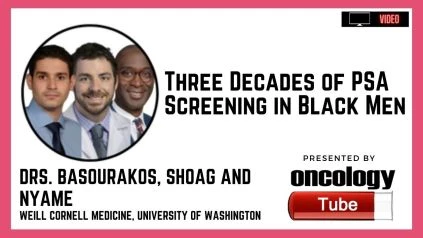Spyridon Basourakos, MD, Urology Resident 5th year at Weill Cornell Medicine, Jonathan E. Shoag, MD, Adjunct Clinical Assistant Professor of Urology Weill Cornell Medicine Assistant Professor Casewestern and Yaw Nyame, MD, MS, MBA, Assistant Professor, Surgeon, Researcher at the University of Washington. In this video, they discuss the AUA 2022 abstract – LBA01-01: Harm-to-Benefit of Three Decades of Prostate Cancer Screening in Black Men.
Â
Details
Â
Spyridon Basourakos, Roman Gulati, Randy Vince, Daniel Spratt, Patrick Lewicki, Alexander Hill, Yaw Nyame, Jennifer Cullen, Sarah Markt, Christopher Barbieri, Jim Hu, and Jonathan Shoag are among the authors.
Â
Intro:
Â
Prostate-specific antigen screening has had a significant impact on the epidemiology of prostate cancer in the United States. The persistence of racial disparities in outcomes for Black men calls for a reconsideration of the harms of screening in comparison to the cancer-specific mortality benefits in this community.
Â
Methodology:
Â
Using (a) excess incidence relative to 1986 based on the Surveillance, Epidemiology, and End Results registry and US Census data and (b) an established microsimulation model of prostate cancer natural history, we estimated overdiagnosis and overtreatment for all races and Black men aged 50-84 years until 2016, the most recent year with treatment data available. We computed the numbers needed to diagnose (NND) and treat (NNT) to avoid one prostate cancer death by combining estimates with a probable mortality benefit.
Â
Outcomes:
Â
We projected 1.5-1.9 million (range of estimating methodologies) overdiagnosed and 0.9-1.5 million overtreated prostate tumors in all races by 2016. Figure 1 depicts age-standardized prostate cancer incidence divided into overdiagnosed and non-overdiagnosed components based on estimation method and race. Over the period 1986 to 2016, the two estimating methodologies provide identical age-standardized costs of overdiagnosis. Prostate cancer mortality increased initially and subsequently decreased relative to 1986, with 270,000 fewer deaths among men of all races and 55,000 fewer deaths among Black men (Figure 2). Assuming that screening prevented half of the 270,000 prostate cancer deaths avoided by 2016, the NND and NNT for all races would be 11-14 and 7-11, respectively, and 8-12 and 5-9 for Black men. When the lag between incidence and mortality is taken into account, the estimated NND and NNT for black men are in the low single digits.
Â
Findings:
Â
Complementary techniques to assessing overdiagnosis show that prostate-specific antigen screening has a better harm-benefit tradeoff than prior estimates based on shorter follow-up from the start of screening. These findings provide significant support for prostate-specific antigen screening, particularly in Black men, for whom clinical trial evidence is lacking.

